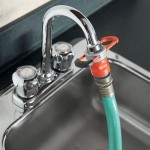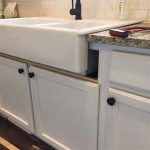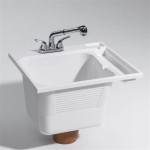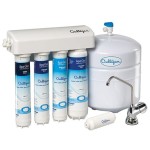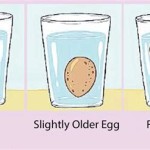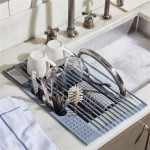The Versatile Over-Sink Cutting Board with Colander: A Kitchen Essential
The modern kitchen demands efficiency and versatility, and tools that streamline food preparation are highly valued. The over-sink cutting board with colander stands out as a prime example of such a tool. This multi-functional kitchen accessory combines the benefits of a cutting board and a colander, offering a convenient and space-saving solution for various food preparation tasks. Its design allows it to sit directly over the sink, maximizing counter space and minimizing mess during chopping, rinsing, and draining.
This article will explore the features, advantages, and considerations associated with the over-sink cutting board with colander, providing a comprehensive understanding of its utility in the contemporary kitchen. It will delve into the diverse materials used in their construction, the varying designs available, and the numerous ways this product can enhance the food preparation process. Furthermore, it will address factors to consider when selecting an over-sink cutting board with colander to ensure optimal suitability for individual kitchen needs and preferences.
Space Optimization and Ergonomics
One of the most compelling advantages of the over-sink cutting board with colander is its space-saving design. In smaller kitchens, counter space is often at a premium. By positioning the cutting board over the sink, it effectively extends the available work surface. This is particularly beneficial when preparing multiple ingredients or complex meals. The design eliminates the need for a separate cutting board and colander occupying valuable countertop real estate.
Beyond space-saving, the over-sink design promotes ergonomic efficiency. The proximity of the cutting board to the sink minimizes the distance food needs to be transferred. This reduces the risk of spills and drips, keeping the countertop cleaner and the work area more organized. Users can easily rinse chopped vegetables or fruits directly into the integrated colander without needing to move them across the counter. This continuous workflow reduces physical strain and streamlines the food preparation process.
The height of the cutting board relative to the sink can also contribute to a more comfortable working posture. Depending on the sink depth and the board's design, the elevated surface may reduce the need to bend over excessively, minimizing back strain during prolonged food preparation tasks. Some models offer adjustable features, such as extendable arms or collapsible frames, allowing for further customization to suit individual preferences and sink dimensions.
Material Properties and Durability
The choice of materials significantly affects the functionality, durability, and hygiene of an over-sink cutting board with colander. Common materials include plastic, wood, and stainless steel, each offering distinct advantages and disadvantages. Plastic cutting boards are generally lightweight, affordable, and easy to clean. They are also non-porous, making them less susceptible to bacterial growth compared to wood. However, plastic boards may be prone to scratching and warping over time, and some types of plastic may not be as durable as other materials.
Wooden cutting boards, particularly those made from hardwoods like maple or bamboo, offer a natural aesthetic and are often considered more gentle on knives than plastic. Wood also possesses inherent antibacterial properties. However, wooden boards require more maintenance than plastic, including regular oiling to prevent drying and cracking. They are also more susceptible to staining and can harbor bacteria if not properly cleaned and sanitized.
Stainless steel colanders are common due to their durability, corrosion resistance, and ease of cleaning. Stainless steel is also non-reactive, meaning it won't impart any unwanted flavors or odors to food. Some over-sink cutting boards incorporate stainless steel components, such as the colander itself or reinforcing structures, to enhance structural integrity and longevity. The choice of material depends on individual priorities, balancing considerations of cost, durability, hygiene, and aesthetic appeal.
The durability of the over-sink cutting board is also influenced by the construction method. Boards with robust frames and secure attachments between the cutting surface and the colander tend to withstand heavier use and last longer. Checking the weight capacity of the board is essential, especially when preparing large quantities of food or handling heavy items like whole melons or watermelons.
Design Variations and Functional Features
Over-sink cutting boards with colanders are available in various designs, each offering unique features to cater to specific needs. The most basic models consist of a flat cutting board with an integrated colander positioned at one end. These designs provide a simple and efficient solution for basic chopping and rinsing tasks. More advanced models may include additional features, such as adjustable arms to accommodate different sink sizes, collapsible frames for easy storage, and built-in graters or mandolines for added versatility.
Some designs incorporate multiple colanders or compartments, allowing for the separation of different ingredients. This is particularly useful when preparing dishes that require a variety of chopped vegetables or fruits. The compartmentalized design prevents cross-contamination and keeps ingredients organized during the preparation process. Certain models also feature drainage systems that allow water to flow directly into the sink, preventing water from pooling on the cutting surface.
The shape of the cutting board can also vary. Rectangular boards are the most common, but other shapes, such as round or oval boards, may be available. The choice of shape depends on personal preference and the intended use. Rectangular boards generally provide a larger cutting surface, while round boards may be more suitable for chopping smaller items like herbs or garlic. The size of the colander is another important consideration. A larger colander is ideal for rinsing larger quantities of food, while a smaller colander may be sufficient for smaller tasks.
The presence of non-slip feet or grips is crucial for ensuring stability and preventing the cutting board from sliding around during use. Non-slip features enhance safety and prevent accidents, especially when working with sharp knives. Some models also include handles or grips for easy lifting and carrying. These features make it easier to move the cutting board from the sink to the countertop or to store it away when not in use.
Another design variation involves the orientation of the colander. Some boards have the colander positioned on the side, while others have it positioned at the end. The placement of the colander affects the balance of the board and the ease of access to the colander. Side-mounted colanders may be more convenient for rinsing ingredients while chopping, while end-mounted colanders may provide more overall cutting surface area.
Hygiene and Maintenance
Maintaining proper hygiene is crucial when using an over-sink cutting board with colander. Regular cleaning and sanitizing are essential to prevent the growth of bacteria and the spread of foodborne illnesses. The cleaning method depends on the material of the board. Plastic cutting boards can typically be washed in the dishwasher, while wooden cutting boards require hand washing with soap and hot water. It is important to dry wooden boards thoroughly after washing to prevent warping and cracking.
To sanitize a cutting board, a solution of bleach and water can be used. Dilute one tablespoon of bleach in one gallon of water and apply the solution to the cutting surface. Allow the solution to sit for a few minutes before rinsing thoroughly with water. This will help to kill any remaining bacteria.
For wooden cutting boards, regular oiling is necessary to maintain their integrity and prevent them from drying out. Food-grade mineral oil or beeswax can be used to oil the board. Apply a thin layer of oil to the entire surface of the board and allow it to soak in for several hours before wiping off the excess. This will help to protect the wood and prevent it from cracking.
It is also important to avoid using the same cutting board for raw meat and other foods, such as vegetables or fruits. Raw meat can contain harmful bacteria that can contaminate other foods. If using the same cutting board, it is essential to thoroughly clean and sanitize it between uses. Ideally, separate cutting boards should be used for raw meat, vegetables, and other foods.
When storing the over-sink cutting board, it is important to store it in a clean and dry place. Avoid storing it in a damp or humid environment, as this can promote the growth of mold and bacteria. Hanging the board or storing it on its side can help to ensure proper air circulation and prevent moisture buildup.
Factors to Consider When Choosing
Selecting the right over-sink cutting board with colander requires careful consideration of individual needs and kitchen specifications. Sink size is a primary factor. The board must be wide enough to span the sink without wobbling or slipping. Adjustable arms or extendable designs can accommodate a wider range of sink sizes.
The material of the cutting board should align with personal preferences regarding durability, hygiene, and aesthetics. Plastic is a cost-effective and low-maintenance option, while wood offers a natural look and feel. Stainless steel combines durability with hygiene, though it may be more expensive. Knife compatibility is another consideration. Softer materials, like wood, are generally gentler on knives than harder materials, like plastic.
The size and shape of the cutting board should be chosen based on typical food preparation tasks. A larger board is suitable for handling larger items or preparing multiple ingredients, while a smaller board may be sufficient for smaller tasks. The presence of additional features, such as adjustable arms, collapsible frames, or built-in graters, should be evaluated based on their potential utility in the kitchen.
Finally, the budget is always a factor. Over-sink cutting boards with colanders are available in a wide range of price points, depending on the materials, construction, and features. It is important to balance the desired features with the available budget to find a product that offers the best value for money. Reading reviews and comparing different models can help to make an informed decision.

Over The Sink Cutting Board W Removable Colander Handmade Large Cover For Kitchen Etsy

Rw Base Gray Plastic Over The Sink Cutting Board With Collapsible Strainer 19 3 4 X 11 1 Count Box

Domestify Plastic Over The Sink Cutting Board Removable Collapsible Strainer Red 19 5 X11

Classic Cuisine 2 In 1 Cutting Board With Strainer

Good Cooking Over Sink Cutting Board With Collapsible Colander Camerons S

Rw Base Gray Plastic Over The Sink Cutting Board With Collapsible Strainer 19 3 4 X 11 1 Count Box

Domestify Plastic Over The Sink Cutting Board Removable Collapsible Strainer Red 19 5 X11

Hastings Home 13 2 In L X 11 5 W Wood Cutting Board At Com

This 3 In 1 Over The Sink Cutting Board Lets You Clean Chop And Collect

Large Over The Sink Black Walnut Edge Grain Cutting Board With Colande Springhill Millworks
